
 On May 6th, philosopher and Sussex University lecturer Kathleen Stock published her book, ‘Material Girls’, subtitled ‘why reality matters for feminism’. Just one day after publication, it had hit number 49 on the Amazon bestseller list.
On May 6th, philosopher and Sussex University lecturer Kathleen Stock published her book, ‘Material Girls’, subtitled ‘why reality matters for feminism’. Just one day after publication, it had hit number 49 on the Amazon bestseller list.
“Material Girls is out today,” wrote Stock on Twitter, on the morning of 6th May. “I wrote it because collectively, our institutions, educators, and political leaders are under a spell; and because there’s been a concerted movement to shut down discussion of that fact, and what it means. Here’s to a conversation #YesItsADebate”
 I attended the online booklaunch organised by A Woman’s Place UK where Stock talked with Suzanne Moore.
I attended the online booklaunch organised by A Woman’s Place UK where Stock talked with Suzanne Moore.
“I’m mostly considered an outsider to the area (of sex and gender)” Kathleen told Suzanne at the book launch,” I’m not even a proper feminist philosopher- at least, I didn’t used to think I was.”
Indeed, Stock’s original area of philosophical interest is not feminism, but fact and fiction, imagination and belief. Her Sussex University profile says,“I’ve written on such questions as: what is imagination?; Are there different kinds or uses of the imagination, and what are they?; Are there limits to what we can imagine?; What are the relations between imagination and belief?; What kinds of imagining does fiction require of the reader or viewer?; What is the difference between fiction and non-fiction?; What is fictional truth?; and much else besides.”
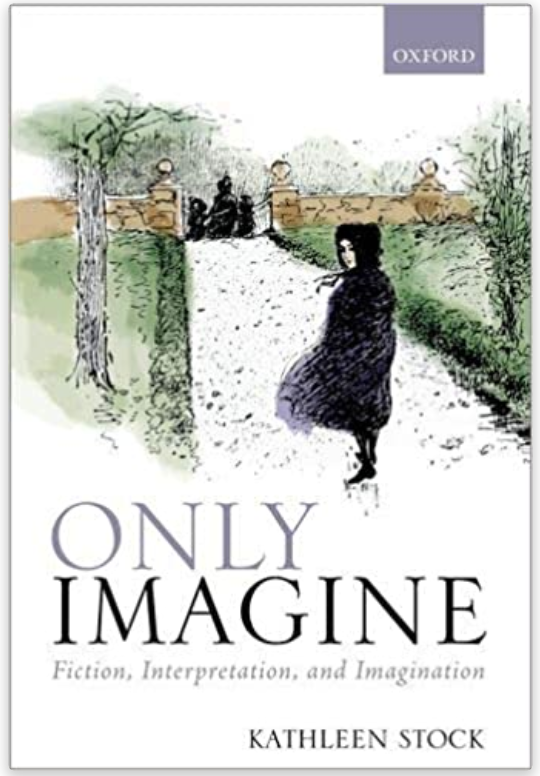 Material Girls is not her first book: in September 2017 Only Imagine: Fiction, Interpretation and Imagination was published by Oxford University Press.
Material Girls is not her first book: in September 2017 Only Imagine: Fiction, Interpretation and Imagination was published by Oxford University Press.
Whilst I don’t agree with everything Kathleen says – I literally feel an ache in my stomach when men are given the ‘courtesy’ of preferred pronouns- the book is well structured and the first sections give a good background to gender identity politics and how we got to where we are today.
A Brief History of Gender Identity

Kathleen Stock & Suzanne Moore
Speaking with Suzanne Moore at the ‘Zoom’ book launch, Stock is quick to point out, “I’m not a historian, so I really do hope that we’ll have in the coming years some much richer investigations as to how we got where we are.” She reminded the audience that Helen Joyce’s book will be published soon and advised us to read that.
Stock does not refer to it in Material Girls, but I would add that Janice Raymond’s The Transexual Empire gives a historical perspective. Published in 1979 it was updated in 1994, and you can read it online here.
Stock begins by discussing the concept of gender identity and ‘the four axioms of modern transactivism’, including the idea that it is your gender identity, not your sex, that makes you a woman or a man. She also reminds her readership that while she is critical of gender identity theory, she has a ‘friendly sympathy and respect for trans people’.
Respect is a confusing word in this context. I would not claim to give my respect to someone unless there was something specific I admired about them or their work. Respect is earned. Is there something generic to be respected about trans-identified people? Or does Stock mean respect as in ‘I respect people’s human rights?’ It seems likely that this is just another way of saying “I’m not transphobic”, which seems a little pointless, if understandable in the light of the attacks she has recived for daring to question trans-ideology.
Stock divides this history into eight ‘moments’ starting with the thoughts, work and influences of Simone deBeauvoir (a woman is expected to be whatever a man wants), Money and Stoller (a gender role is behavioural), Anne Fausto-Sterling (there are five sexes, not two), Judith Butler (no performance of gender is more appropriate or authentic than any other) and Julia Serano (I’m a trans woman you’re a cis woman). She then deals with the Yogyakata Principles (recognition of gender identity as a human right), the concept of a TERF (trans-exclusionary radical feminist), and ‘an explosion of identities’ (there is more to gender identity than man, woman and non-binary) in which she touches briefly on the huge increase in children presenting to the Tavistock.
The links between queer theorists and paedophile apology are not mentioned but perhaps this book is not the place for that discussion.
How many genders?

Kathleen Stock
“One meaning of gender is the kind of social and cultural meanings around sex and that’s fine, we need a word for those things,” Kathleen told Suzanne in conversation at the book launch.
Judith Butler seemed to believe, she added, that if you defined womanhood in a way that wasn’t biological, if you distinguished between sex and gender, you could somehow circumnavigate the threat of biological determinism:the idea that women are pre-programmed to be ‘domestic and not very bright and good at home-making’.
“And as I say in the book, that’s a bit like trying to get out of the earth being hit by an asteroid by redefining the earth as something that cannot be hit by an asteroid. It will make absolutely no difference to the empirical facts…”
Far from silencing advocates of biological determinism, the suggestion that woman is a way of behaving, a social role, or a way of being perceived has, in Stock’s words, ‘opened up a whole new space for people to insert themselves into.’
In Material Girls, Stock establishes the word ‘gender’ as meaning different things in different contexts. Kathleen suggests that there are four meanings: here described in my own words & simplified.
GENDER1- biological sex
GENDER2 -stereotypes of masculinity & femininity
GENDER3- the divide between those who have masculine & feminine social roles thrust upon them
GENDER4- short for ‘gender identity’
For those of us deeply embroiled in gender issues, it can be easy to forget that Josie & Joe Bloggs probably think of the words sex and gender as interchangeable. This confusion goes a long way to explaining how we have become so tangled up in the woowoo (my words, not Kathleen’s) that it sometimes seems like there’s no way out. A discussion on the different meanings of the word ‘gender’ is certainly a good starting point.
Stock concludes the chapter by issuing a ‘defence of debate’, tackling the charge that any criticism of gender identity of transactivism is transphobic and observing that people can look at the same data and come to different conclusions. Theories, says Stock, should be tested, discussed and ‘available for robust critical examination’.
In an attempt to avoid the clunky, inadequate and inaccurate phrase ‘gender non conforming’ Kathleen describes herself as a ‘sex non-conforming woman’, which doesn’t seem to quite work either, causing one cynical reader to ask “WTF does that mean??? By dint of will she refuses to ovulate and menstruate???“
Which brings us on to the next big question-
What is sex?
 In chapter two, Kathleen asks the big question ‘what is sex?’, observing wryly “Partly, it’s assumed to be psychologically important to trans people that others don’t refer to sex at all.”
In chapter two, Kathleen asks the big question ‘what is sex?’, observing wryly “Partly, it’s assumed to be psychologically important to trans people that others don’t refer to sex at all.”
Discussing the idea pushed by many transactivists and queer theorists that there are not two distinct biological sexes, Stock explains that there are three main accounts of what sex is, the gamete account, the chromosome account and the cluster account, concluding, “the common objections to the idea of two sexes do not threaten any of them” and that it is not possible to change sex.
This section of the book is necessarily dry, dealing with intersex issues, referencing SRY genes, how some females can be X,XXX, XXXX or XXXXX and a condition called 46,XX/46,XY. Clusters of morphological characteristics, homeostatic property clusters and virilised external morphology all make an appearance. Occasionally my mind wanders, as it is wont to do when challenged, and I have to draw it firmly back and read a page a second time.
Later discussion and dismissal of Julia Serano’s suggestion that there’s no such thing as male or female because we can’t see chromosomes leaves me distracted by Stock’s insistence on referring to Serano as ‘she’. Serano, author of the book ‘Whipping Girl’ and coiner of the word ‘cis’ is, of course, a man.
“She’s a trans woman,” Kathleen explained to those in the book launch audience who may understandably have presumed a woman’s work was being discussed because of the use of female pronouns, and I found myself both baffled and irritated. Serano is a MAN. Serano’s insistence that he be referred to as a woman is a huge part of the problem we are facing.
Throughout the book Kathleen refers to men who claim to be women as ‘she’. I find this incredibly distracting, rather like somebody approaching me from behind and honking a loud horn in my ear while I’m trying to read. Any time I refer to a trans-identified man as ‘he’ in this article, it is because I have chosen to correctly sex him. Likewise, Stock uses the phrase ‘trans women’ to refer to trans-identified men. Unless I am quoting her directly, I will use the phrase ‘trans-identified men’.
Among the work of other writers, Judith Butler’s ‘startling conclusion’ that sex is a social construct is unpacked and dismissed as ‘adolescently, simplistically monotonic’.
 In one of my favourite passages in the book, Stock observes:
In one of my favourite passages in the book, Stock observes:
“For the person of a certain mindset, Butler is the Harry Potter of philosophy, transforming boring old truisms about the material world into something alchemical, shifting and sexily impermanent.”
In conversation with Suzanne Moore, Kathleen says: “I did cherry pick some bits of Butler for when I wrote about gender identity: I think actually some of the things she says about gender identity are sensible. But what I object to in Butler is that she has this all encompassing metaphysical position… Butler specifically picks on sex as the one thing that she just will not allow you to talk about as if it were as a real thing… but she allows for all sorts of things like environmental catastrophe… “
Moore agrees, observing that gravity presumably existed before somebody called it gravity.
A natural conclusion to be drawn from Butler’s suggestion, observes Stock, is that there are no chemical elements or biological species, no atoms or molecules, no viruses or bacteria.
Other conclusions drawn from this way of thinking are Sally Hines observation, inspired by the ruminations of Thomas Laqueur, that ‘before the enlightenment the female skeleton didn’t exist’. (To be fair, Laqueur also says he has ‘no interest in denying the reality of sex’.)
 Stock delves into his work a little more and I can only reflect that I’m glad I haven’t had to read it, or, perish the thought, been seated next to him at a dinner party.
Stock delves into his work a little more and I can only reflect that I’m glad I haven’t had to read it, or, perish the thought, been seated next to him at a dinner party.
I admit had never heard of Laqueur. I had to look him up. He has written a book called ‘Solitary Sex: A Cultural History of Masturbation’. No, really.
Why does sex matter?
The next chapter ‘Why does sex matter?’ is pretty neatly summed up in the first sentence. The sexes matter because our species would die out without them. Stock discusses sex-associated trends and the nature/nurture debate (although she doesn’t call it that) and the difference sex makes to medicine, sport and sexual orientation, making clear her position that yes, sex matters.

Hannah Mouncey
The fragrant Veronica Ivy, aka Rachel MCKinnon, aka Rhys McKinnon, is addressed with female pronouns, as is Hannah Mouncey, a 6ft 2″ football player who complains about weight restrictions in female categories, even as Stock discusses the absurdity of his claim that excluding him from women’s sport gives a ‘dangerous and backward’ message to women and girls about size.
Of Jonathan Liew’s suggestion that the success of male (my word) athletes in women’s sports could be an ‘inspiring’ role model for trans kids, Stock observes “Liew forgets that females have ambitions or feelings.”
I think we need to remember that a man by any other name remains a man.

Alex Drummond
Sexual orientation, she points out, needs sex to exist in order to exist. Hetero and homosexuality are not choices: ‘a sexual orientation is for life, not just for Christmas parties’. To explain sexual orientation, we need to know a person’s sex and the sex of the kind of person they are attracted to. The rise of gender identity means that sex becomes irrelevant to sexual orientation and thus, hey presto, Alex Drummond claims, ostensibly without irony, “certainly I draw out the inner lesbian in women!”
“If we had to work out someone’s gender identity before we knew who to fancy, we would die out pretty quickly,” points out Kathleen, dismissing the idea that genital preferences (my phrase, not hers) are bigoted or transphobic.
Knowing what sex somebody is, she adds, is also important for data collection. Many of us may have noticed the suspicious increase in the number of women robbing banks, masturbating in public and committing sex crimes. Stock observes that males are responsible for the majority of assaults against females and that these behavioural differences are “at least partly explicable in terms of typical differences between males and females in strength, size and direct aggression.”
This situation, she acknowledges, is what led to the establishment of single-sex spaces for women. Recently, many organisations, especially those that are Stonewall Diversity Champions, have decided that gender identity is now ‘the only critereon for legitimate entry’.
“Sex and gender identity should not be placed in competition,” she concludes.
I can’t help feeling that is exactly what is happening when you refer to men as ‘she’.
What is gender identity?
 Chapter four deals with the million dollar question of gender identity and the legislation surrounding it. Stock observes that many ‘non-trans’ people are unhappy with their sex without wishing to transition and discusses the somewhat unconvincing ‘stick of rock’ gender identity model, which I had not heard of prior to reading Material Girls.
Chapter four deals with the million dollar question of gender identity and the legislation surrounding it. Stock observes that many ‘non-trans’ people are unhappy with their sex without wishing to transition and discusses the somewhat unconvincing ‘stick of rock’ gender identity model, which I had not heard of prior to reading Material Girls.
The stick of rock model suggests that gender identity is innate. Stock argues that the SOR model ignores the fact that a misaligned gender identity could be formed in a developmental context. Are we aware of our gender identity? Do gay people have different brains? Stock discusses the idea of the ‘female brain’. Some researchers, we are told, suggest that they’ve found two areas of the brain that are ‘more similar in trans women and non-trans women than in men’.
Yes, women really are referred to as ‘non trans women’. I’m reminded of the subtitle of the book, ‘Why Reality Matters for Feminism’ and for a moment I am quite honestly not sure which way is up.
Stock offers us three models of gender identity, the medical model, the queer theory model and the identity model.
The medical model
The medical model sees a ‘misaligned’ gender identity as a mental health issue, one which we commonly name gender dysphoria. Gender dysphoria can be diagnosed after a period as short as six months of feeling like your gender doesn’t match your body. The DMS-5 – which really should know better, doesn’t differentiate between sex and gender,and also talks about ‘assigned gender’, meaning that it’s pontifications on the subject are basically woowoo. While the medical model offers potential solutions in the from of hormones and surgery, it both pathologises and normalises a ‘misaligned gender identity’.
The Queer Theory Model
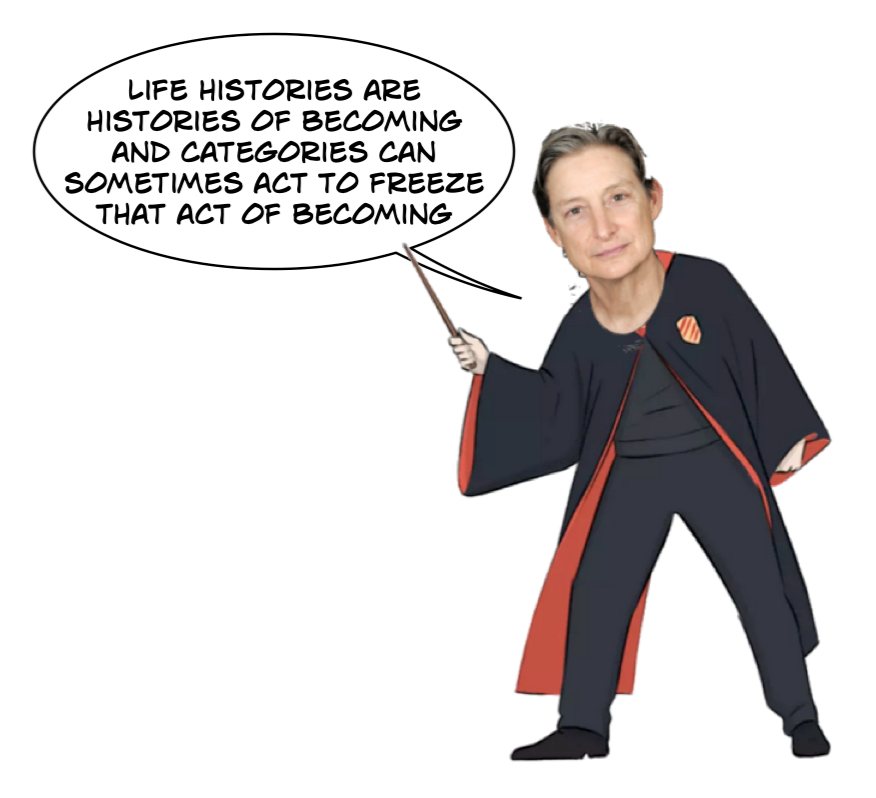 Back to Butler we go. Butler holds that all categories for humans are socially constructed. Stock thinks queer theorists have some interesting things to say about gender identity. She talks of sex-non-conforming bodies and behaviours. Non-performative transsexuals are touched upon. The concepts of demi-fluid and pangender are briefly explored.
Back to Butler we go. Butler holds that all categories for humans are socially constructed. Stock thinks queer theorists have some interesting things to say about gender identity. She talks of sex-non-conforming bodies and behaviours. Non-performative transsexuals are touched upon. The concepts of demi-fluid and pangender are briefly explored.
‘These identities are fairly incomprehensible’ writes Stock. So we are in agreement on that.
The identification model
We can identify with all sorts of things, other people, sports teams, pets, or even nature. Identification, writes Kathleen, involves ‘desire or yearning to be like, or sometimes even to merge with, another’. DSM-5 talks of a ‘strong conviction that one has the feelings and reactions of ‘the opposite sex. She feels there is more to this than attraction to ‘regressive social stereotypes of femininity’ and suggests it is strange to blame men (she doesn’t call them men) for their attraction to these stereotypes when so many women are attracted to them, and blames ‘general disgust and prurience’ for such reactions.
She does however, object to the idea that children’s preference for certain toys, clothing and hobbies could mark them out as transgender, and she touches on the prevalence of ASD children in this cohort.
Some men and some women are attracted to the extreme stereotypes associated with their sex, and this could perhaps be called an ‘aligned’ gender identity, she speculates, concluding that there may be a case for making gender identity a protected characteristic- or perhaps sex-non-conformity.
What makes a woman?
“… when was it that you realised actually that you were a kind of heretic?” asks Suzanne Moore at the book launch.
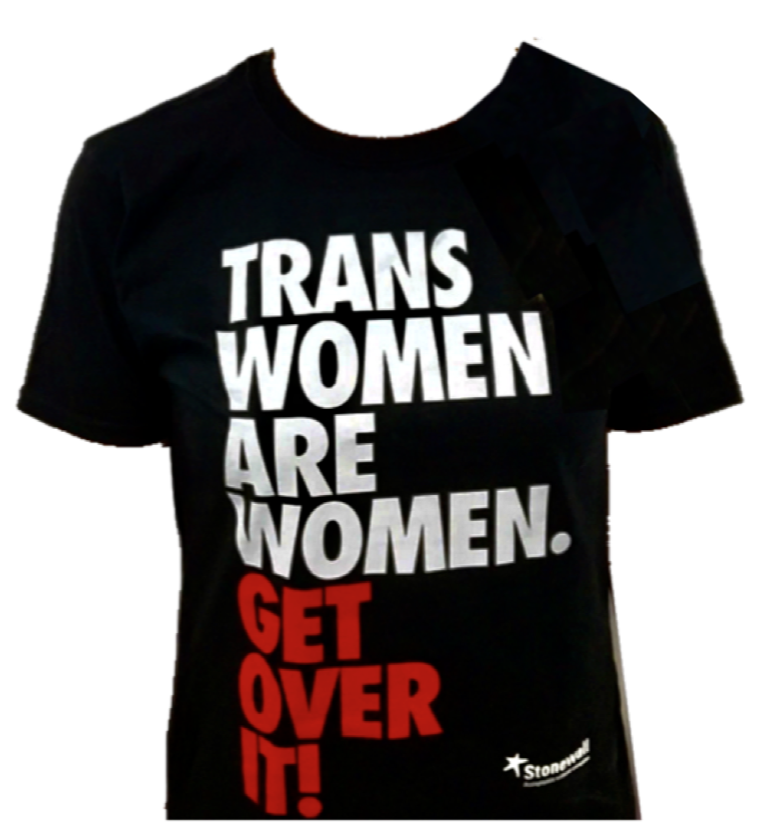 Kathleen said she remembers being struck by the ‘very aggressive and literal assertion’ of the Stonewall slogan, ‘Trans women are women. Get over it’, and the demand that the idea must be taken literally; that women must ‘not complain about it or examine it, just accept it.”
Kathleen said she remembers being struck by the ‘very aggressive and literal assertion’ of the Stonewall slogan, ‘Trans women are women. Get over it’, and the demand that the idea must be taken literally; that women must ‘not complain about it or examine it, just accept it.”
Whilst it was Stock’s response to this slogan that made her realise she was ‘at odds with the emerging orthodoxy’ she told Moore, she has ‘never believed the story’ and she doesn’t think a lot of other people believe it either. Not even ‘those who mouth mantras’.
In this chapter Kathleen speculates as to what makes a woman or a man. In trying to answer the question, she suggests, ‘you’re more like a spy doing reconnaisance work than a bouncer at a club’.
In discussing the value of concepts: she points out that ‘over two years old’, for example, is a fairly useless concept. If everything over two years old became lethal to touch, we’d find a ‘pithy handle to refer to it pretty quickly’. She talks of conceptual analysis and the function of a woman as a concept.
Gender identity theorists want to change the concept of what it is to be a man or a woman. She acknowledges that ‘talk of assignation makes no sense’ (phew). Even if  gender identity theorists are right about what makes a man or a woman, she argues that the traditional definitions are still fit for purpose (phew again).
gender identity theorists are right about what makes a man or a woman, she argues that the traditional definitions are still fit for purpose (phew again).
Stock acknowledges that the biological fact of being a woman is essential to many of the problems women face, in society, the workplace and in the pursuit of economic or political power. She also speculates on the effect that telling a child that a man (she doesn’t say man) is a woman might have on that child’s ’emerging conceptual map of the world’.
Stock asserts that if we were to make the linguistic changes that transactivists (my word) demand, we would still need words to describe, for example, the human females who give birth, or the adult human females attracted to other adult human females; if we aren’t supposed to refer to lesbians, mothers, fathers or daughters in the traditional sense, we will need to come up with new words to describe these concepts, because we will still need to identify these important groups. If we did end up doing this, transactivists (my word) would be unlikely to be satisfied in the long run – queer theorists would still see it as ‘normative exclusion’.
Stock suggests a solution might be adding different cross-categories, for example, men could be ‘adult human males with female gender identities’.
I’m pretty sure that wouldn’t be enough for them either.
A hierarchy of interests
Men, not women, are responsible for the majority of violent crimes, and women are likely to fare worse in the workplace. These things are linked to biology in explicable ways: women are physically weaker and the sex class that bear children. The world is set up in favour of men. Stock says that treating men with female gender identites as women ‘in every possible context is a politically inflammatory act’.
I would say that treating men with female gender identities as women in any possible context was a politically inflammatory act.
Trans isn’t, she says – thankfully, because I was beginning to wonder for obvious reasons- an adjective attached to ‘woman‘. Trans women are not women in the sense that adult human females are women. Stock expects her reader to possibly be surprised by this conclusion, and maybe many will be. I’m just relieved she’s come to that conclusion.
She goes on to add that she thinks changing your body to look like the opposite sex is reasonable and to acknowledge the relief this gives some trans people- then she adds that she isn’t saying trans women should never call themselves women.
There’s nothing wrong with being ‘sex non-conforming’, she says.
From my perspective- a brief aside
I wish I had started writing a less comprehensive review. I’m told the average length of a book review is about 1,500 words and I’ve already tipped 5,000. I suspect that more people would have read it had I kept it shorter, and it would inevitably have been much, much less work. A problem I have here is differentiating between Kathleen’s words and mine. I would say ‘men’ or ‘trans-identified men’. I would say ‘gender non-conforming’ because I don’t grasp how it’s possible to be ‘sex non-conforming’ unless, perhaps, you are intersex. I would never use the phrase ‘trans woman’ because no matter how much you claim it isn’t an adjective, it seems like one if it’s written like that. I worry that I may have misinterpreted some of Kathleen’s ideas; I’m unfamiliar with the work of many of the people she mentions. I’ve probably missed out some important bits. It’s with some relief that I approach the next chapter, to my mind the most interesting of them all, which goes in some way towards explaining why so many of us have drunk the Kool-Aid and are willing to chant the prescribed mantras.
Immersed in a fiction
This chapter is by far my favourite, dealing with an idea that I had not previously given much thought and which goes a long way to explaining how the ‘transwomen are women’ narrative has been accepted with such enthusiasm by the mainstream.
Earlier I mentioned that Stock tells Moore she has ‘never believed the story’ and she doesn’t think that even ‘those who mouth mantras’ believe it either.
“I think they’re immersed in a fiction,” said Stock, “which is understandable and maybe therapeutically beneficial for some people. But it’s also got its costs, so I think we need to examine that.”
Stock gives examples of how we behave when we are immersed in a fiction, for example when we watch a film or television.
This is the example that sprung to mind as I read this chapter in Material Girls. When I watch a performance of Romeo & Juliet, I am totally invested in the play. I am desperately willing Romeo not to take the poison every time, even though I have seen it a dozen times and I know the inevitable outcome. I may be standing at the Globe, my feet aching, wishing I’d brought a coat, surrounded by 200 other people, but I am entirely invested in the characters, I am immersed in a fiction.
 In the 1996 film version, where Danes’ eyes flicker open and her hand reaches for his cheek even as DeCaprio uncorks the poison, for one incredible moment I felt a genuine hope that it might all work out this time, and when- of course- it didn’t, my emotional response was astonishing. I literally sobbed. This is an excellent example of being immersed in a fiction. You know what’s happening isn’t true, but you respond as if it is.
In the 1996 film version, where Danes’ eyes flicker open and her hand reaches for his cheek even as DeCaprio uncorks the poison, for one incredible moment I felt a genuine hope that it might all work out this time, and when- of course- it didn’t, my emotional response was astonishing. I literally sobbed. This is an excellent example of being immersed in a fiction. You know what’s happening isn’t true, but you respond as if it is.
Despite my emotional reaction to this scene every time I see it, it has never crossed my mind to leap onto the stage and dash the poison from Romeo’s hands because, despite the tears pouring down my cheeks, I know what’s happening isn’t real.
“Most of the time I choose to immerse myself in a fiction about sex change for trans people where it seems they would wish me to.” clarifies Stock, admitting that she remains ‘genuinely conflicted’.
Stock explains the reasoning behind the ‘legal fiction’ of a gender recognition certificate (GRC) and the complexities around laying this out in law. The law feels that a person’s efforts to appear and live as the opposite sex should in some way be rewarded by validation. The GRA allows a person’s gender to become ‘for all purposes the acquired gender’ but then promptly lists circumstances where it is not necessary to act as if somebody with a GRC has literally changed sex, citing ‘parenting definitions, peerages, sport and ‘gender specific’ sexual offences’.
And so that insane conflation of sex and gender raises its head yet again.
Stock examined debate transcripts and observes the inconsistencies involved: “at times they talked as if granting a GRC would- impossibly as I argued in Chapter 2- literally change its possessor’s sex.”
Of course, she notes, it is possible to be immersed in a fiction about sex and not have a misalligned gender identity- and vice versa.
Another of the of the defining features of being immersed in a fiction- think Romeo & Juliet again- is that you’re not thinking consciously about how it isn’t real. When I wept watching Dines and deCaprio’s final scene unfold, I wasn’t thinking about the camera crew, the lighting director, the number of takes the scene took & whether it was vodka or water in Leo’s ‘poison’ bottle. I knew they weren’t really the doomed Romeo and Juliet, but I responded as if I believed they were.
“Immersion can be individual but it can also be collective,” writes Kathleen. “… when you’re immersed collectively in a scenario, normally you are incentivised to prevent others drawing attention to it’s fictional nature.”
This chapter made a lot of sense to me. People know it isn’t true but they also think it is. Politicians and celebrities, and the rest, chanting ‘transwomen are women’ are not ‘deluded, duped or deceived’ when in an immersion, because on some level they know it isn’t true.
Stock adds that ‘some trans people enter immersively into a fiction on the assumption that it will be implicitly understood by others as a fiction’. Others will want relief from dysphoria. I find her claim that ‘either way there’s no automatic deceptive intent, nor eventual deceptive fact’ to be naive and misguided. More about what I would loosely call Stock’s ‘autogynophilia denial’ later.
For some young women, immersion in a trans identity can help navigate puberty. Many, as Abigail Shrier says, are ‘fleeing womanhood like a house on fire, their minds fixed on escape, not on any particular destination.’ What starts as theraputic can end up being harmful when the subject become over invested and gets in too deep. Social media can exacerbate this because it is easy to create your fiction. ‘You’re the playwright,’ as Kathleen says. But sometimes this fantasy ‘calcifies’ a narrative which might not be good or right for you. Not everyone has the ability or the inclination to entirely immerse themselves in the fantasies of others, so it can also cause problems with relationships. Children are especially vulnerable to misconstruing the illusion of immersion.
Stonewall, Kathleen notes, defines ‘transphobia’ in part as denying someone’s gender identity or refusing 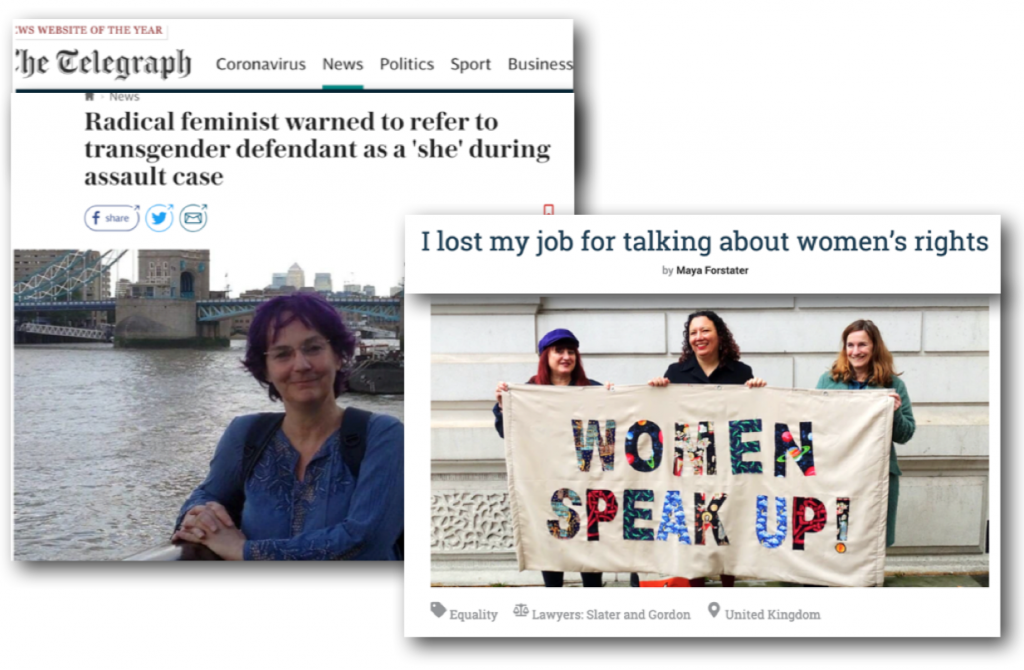 to accept it. This includes ignoring someone’s preferred pronouns or speculating about their sex. The Stonewall Diversity Champion scheme has captured our schools, government, NHS and legal system by offering rewards to those who comply with their ideology. She discusses the cases of Maria MacLachlan and Maya Forstater and observes that in these cases ‘the judges’ rulings ‘didn’t come from nowhere’: the CPS actually advises that ‘preferred pronouns’ should be used in court.
to accept it. This includes ignoring someone’s preferred pronouns or speculating about their sex. The Stonewall Diversity Champion scheme has captured our schools, government, NHS and legal system by offering rewards to those who comply with their ideology. She discusses the cases of Maria MacLachlan and Maya Forstater and observes that in these cases ‘the judges’ rulings ‘didn’t come from nowhere’: the CPS actually advises that ‘preferred pronouns’ should be used in court.
Stock is interested in the Stroop-effect discussed in Barra Kerr’s ‘Pronouns are Rohypnol’ but dismisses as ‘fearmongering’ the idea that ‘trans women’ may exploit this. I would say that there are examples of this all over social media – it seems pretty clear that there are plenty of trans-identified men with nefarious intent.
Kathleen refers to the mis-reporting of newspapers who refer ‘even to convicted criminal trans women’ with female pronouns, observing “the use of sex-incongruent language can send a misleading set of impressions to a reader’s subconscious.” Well, yes.
Stock says she will not refer to convicted rapist Karen White, or other “trans women who assault or aggress women” as ‘she’ or ‘her’. She does however refer to White as a ‘trans woman’. This does not strike me as rational. It also opens up an entirely new philosophical debate. How well-behaved do you have to be to win the prize of womanhood? As I’ve said elsewhere, we don’t get to decide who is ‘good enough’. We’re not Father Christmas.
 Stock suggests we might use ‘they‘ if we can’t bring ourselves to use preferred pronouns. She speaks of using the ‘rich resources of the English language’ to compromise unless it is specifically important or relevant that sex be acknowledged. Why? Previously she asserted that nobody should be coerced into an immersion- how is this any better? We need the word ‘woman‘ just as much as we need the words ‘she‘ and ‘her‘.
Stock suggests we might use ‘they‘ if we can’t bring ourselves to use preferred pronouns. She speaks of using the ‘rich resources of the English language’ to compromise unless it is specifically important or relevant that sex be acknowledged. Why? Previously she asserted that nobody should be coerced into an immersion- how is this any better? We need the word ‘woman‘ just as much as we need the words ‘she‘ and ‘her‘.
“I’m just talking about whether it’s inner feelings that should be protected in law or something else.” Kathleen told Suzanne at the book launch. “And I’m arguing about what it means to say ‘I’m a woman’ whether you’re male or female. And I realise it is distressing probably for some people to hear that I think it’s a fiction: because perhaps they believe it themselves or they just don’t want to be reminded of that, and I’m sorry about that. And I’m certainly not going to go up to an individual trans person and say this.”
How did we get here?
Well, in part by using bloody ‘preferred pronouns’ in an attempt to be nice and compromise!
“Why has ideologically driven policy-capture been so easy?”
Stock suggests it’s partly because people are keen to make up for prior prejudices against lesbian and gay people and the embarrassment of Section 28. Some people may associate the T with being gay because some gay men are effeminate and some lesbians are butch. Despite the big differences between the T and the LGB, many organisations originally went along with Stonewall policies for the above reasons.
Trans propaganda has also driven policy-capture: the Trans Day of Remembrance  exploits the deaths of South American prostituted people to infer that acts of violence against trans-identified people everywhere are both widespread and motivated by transphobia.
exploits the deaths of South American prostituted people to infer that acts of violence against trans-identified people everywhere are both widespread and motivated by transphobia.
“The victims deserve better than being instrumentalised to make vague political points” observes Stock.
Roughly one trans-identified person per year is murdered in the UK – suggesting that trans-identified people are actually slightly safer than the rest of the population. Suicide statistics are also shamelessly misrepresented and exploited by organisations like Mermaids, and reports of hate crime can include simple acts of ‘misgendering’.
Objectification & autogynephilia
Stock then writes several interesting pages on objectification, discussing stereotypes across cultures and how children are exposed to dehumanising sterotypes of womanhood from an early age, touching on the self-objectification of women and the role of pornography and acknowledging that trans-identifed men often “draw upon highly sexualised and objecitfying stereotypes of womanhood in constructing their public images.”
She acknowledges that autogynephilia can lead to a desire to transition, and that many men (my word) who have the condition deny it, while being both aroused by the idea of themselves as female and deriving security and comfort from the idea.
Whilst Stock discusses the thoughts of Serano, Long Chu “Andrea Long Chu writes in her book…” and Moser, no space is given to the pivotal work of Janice Raymond or Sheila Jeffreys. Stock is, in fact, dismissive of what she calls Jeffreys ‘oversimplification’ of autogynephilia.
Jeffreys is a prolific radical feminist scholar and activist of no mean achievement and one who surely deserves a little more consideration in a work on this subject. Her book Gender Hurts among others, is an essential feminist text. Many people reading this review will be aware of the controversy surrounding Stock’s reference to Jeffreys, so here it is:

Not all ‘trans women’ are autogynephiles and not all autogynephiles transition, observes Stock who accuses radical feminists of ‘stigmatising and overemphasising’ the connection between the two. Kathleen claims to prefer what she calls ‘evidence based feminism’ .
 It seems strange to me that Stock has not read more about the experiences of the numerous women who have lost their husbands to autogynephilic transition and the damaging effects it has on women and children.
It seems strange to me that Stock has not read more about the experiences of the numerous women who have lost their husbands to autogynephilic transition and the damaging effects it has on women and children.
Tinsel, from Trans Widows’ Voices told me:
“The casualties of autogynephilia (AGP) are trans widows. Why shouldn’t AGP be stigmatised when there is increasing evidence that it inevitably involves abuse of women, and in particular domestic abuse?… Julia’s article that Stock quotes was in part written to make the point that I have been making for a long time, that feminist groups platforming our exes excludes trans widows. Stock seems to be presenting this as some kind of radical, fringe view. That feminism should be for females should not be seen as extreme.” She adds, “Trans widows views cannot be more widely heard in feminist groups if our perpetrators are being platformed, so to support that, whilst at the same time bemoaning that you don’t know enough about us, shows you’re (possibly unwittingly) part of the problem.”
A better activism in future
Stock is clear that she rejects gender identity theory and believes that current trans activism does not serve trans people well, exploiting them for political objectives and terrifying them with activist propaganda into thinking themselves “more vulnerable to violence than they actually are.”
In her final chapter, Stock talks of the current ‘time of online outrage and increasing irrationalism’ and keyboard warriors who type ‘furious snark’ online before switching over to Netflix.
She gives a brief and subjective account of radical feminism-I raised one eyebrow at the phrase ‘something called ‘the patriarchy’- gender critical feminism and third wave feminism (which I would call liberal feminism) and the battle between the factions. I could go into the minor points of this, but I think we can probably all agree that this review is already on the lengthy side, so I made this instead:

However, I did have to re-read the sentence ‘radical and gender critical feminist bear their share of responsibility too’, and the accusation that ‘from this side there is frequent, casual denigration of trans women’s characters and also the commonplace suggestion that any trans woman’s reasons for transition are likely to be malign.’
I am left with the feeling that Stock is NAMALTING; she does not seem to grasp that many women are deeply and genuinely insulted by a man’s suggestion that he could be a woman. My comparison is far from perfect but perhaps we could consider the way in which a native American might be offended by a caucasian changing his name to Akekcheta, donning a feathered headdress and and claiming to be a Sioux. If you view transgenderism as appropriation of womanhood, then the feeling that women as a sex class are under attack is quite natural, however well-intentioned the motives of the individual man banging on the door might possibly be.
Is it any wonder that women are concerned about what Julia Long described to Kellie-Jay Keen as “a grotesque pretence of femininity in the public domain”?
It’s at this point that Kathleen indulges in her own piece of ‘snark’ in reference to Dr Julia Long. Many people reading this review will be aware of the controversy surrounding this, so here it the fragment in question:
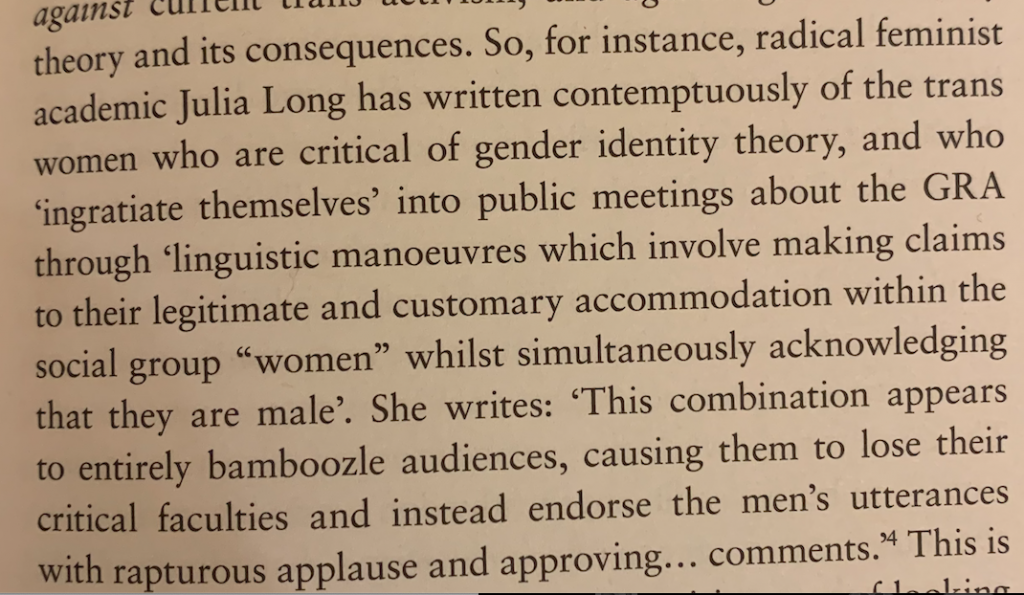 Long is said to write ‘contemptuously’. Do we really need that adverb? As far as I can recall- I may be wrong but I’m not going to read the book a third time this week- nobody else in the book is spoken of quite as disparaging as Jeffreys and Long. The intent of Serano et al escapes such judgement.
Long is said to write ‘contemptuously’. Do we really need that adverb? As far as I can recall- I may be wrong but I’m not going to read the book a third time this week- nobody else in the book is spoken of quite as disparaging as Jeffreys and Long. The intent of Serano et al escapes such judgement.
As mentioned a few pages later, Long has indeed suggested that we do away with the words ‘transexual’ and ‘transwoman’ altogether. This can be a tricky concept to grasp and I understand why some people would disagree with it.
Long explains her position in her article ‘A Meaningful Transition’ where she asks, “If you can’t change your sex, why are the terms ‘transsexual’ and ‘transwoman’ lent credence among British gender critical feminists?”.
In conversation with Kellie-Jay Keen this week, in the broadcast Immaterial Girl, Long described autogynephilia as “a grotesque pretence of femininity,” adding “if she (Stock) thinks it’s being hyperbolised and stigmatised (she should) hear what so called transwomen, male academics, are putting on their syllabuses, because basically it’s their autogynephilia writ large.”
Long recommends anyone who thinks this is hyperbole should watch the recent Women’s Human Rights Campaign video featuring Genevieve Gluk, and look out for Sheila Jeffreys new book.
Whether one agrees or not, would it really be so unreasonable to acknowledge- in a book subtitled ‘why reality matters for feminism’ -that there is at least a point to be argued for calling a man a man? Is it really so unreasonable to feel uncomfortable at seeing women fawning over- for example- a man who expects his students to call him ‘miss’ and has, on at least one occasion, used the women’s toilets at feminist events?
Yet Stock rejects Long’s view as ‘unhelpful and conceptually inadequate’, claiming we need ‘more fine-grained descriptive concepts’. She also suggests that those who are willing to entertain such men as speakers at meetings are not ‘blinded with animosity towards the male sex’, heavily inferring that Julia is. Is there really a need for a personal insult here?
Let’s look at some fine-grained descriptive concepts.
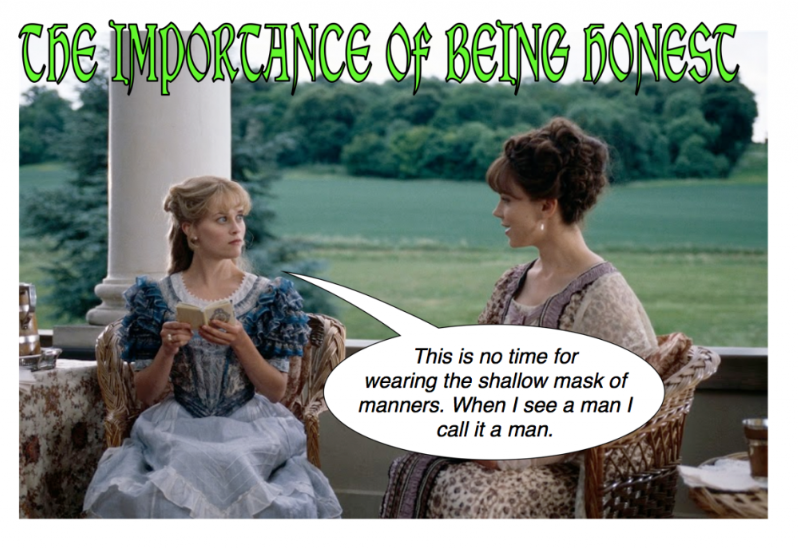 How about trans-identified man? Man who thinks he’s a woman? Man who would like to be a woman? Man dressed in clothing usually worn by women?
How about trans-identified man? Man who thinks he’s a woman? Man who would like to be a woman? Man dressed in clothing usually worn by women?
If reality matters for feminism, does not honesty matter too?
I’d like to be a twenty-five-year-old best-selling writer with the voice of an angel and the looks of a supermodel but I’m not. Nobody is immersing themselves in my fiction.
We have a need for no-nonsense women who refuse to compromise in this movement. Look where being nice has got us. It seems churlish, at very least, to dismiss them in this manner.
Dr Kate Coleman, of Keep Prisons Single Sex told me:
“Two things immediately struck me (about the book): firstly the wholly unnecessary and frankly curious use of the word ‘contemptuously’ to describe Dr Julia Long’s views. This is an unprofessional way to voice disagreement with a fellow academic, whose history of feminist activism and academic work is well-regarded. Yes, the focus was on Julia, but as a radical feminist activist who has long shared this position, I am included in this denouncement.
Secondly the choice of the phrase ‘trans woman’. I understand that choices must be made regarding terminology but the development of that terminology, in my opinion, needs to be considered. ‘Trans woman’ prefixes the noun woman with the adjective trans. Now ‘trans woman’ are simply another sort of woman: like black women, Jewish women, disabled women. And we have seen where that takes us.
I’d also like to make a couple of corrections to erroneous claims in the Introduction. Gender reassignment was already a protected characteristic in the legislation that pre-dated EA (the Equality Act) (2010). The practice of housing TW (transwomen) in the female prison estate goes back to at least the 1980s, far earlier than the date of 2016 that Stock gives… this is crucial to understanding the process, extent and nature of institutional capture.”
Kathleen suggests that trans people are stuck between those who say their sex should never be referred to and those who say it always should. This is somewhat misrepresentative. I don’t know anyone who, on seeing a trans-identified man walking down the street, would feel the need to rush over to him yelling, ‘you’re a man!’.
Should we always refer to a cat as a cat? Well, yes. That isn’t to say that every time we see one we have to shout ‘you’re a cat!’ at it.
I agree with Stock’s observations about the provision of third spaces where ‘women and men who either look or feel unlike their own sex can use facilities and feel more comfortable’. There’s no reason why mixed-sex or ‘gender neutral’ toilets and changing rooms should not be provided- alongside single sex ones. If anybody on the radfem/gender critical side is arguing against this as a possible solution, I’ve missed it. The few people I’ve heard argue against it are trans-identified men. Because, to use Kathleen’s own concept, it draws attention to the fictional nature of their immersion.
Stop changing the subject
Whilst acknowledging the importance of intersectionality as a useful tool for analysing systems of discrimination, Stock asserts that “the people in change of organisations that purport to represent these groups need to stop changing the subject.”
She goes on to discuss how feminism is being co-opted by those who claim it is a movement for everyone. (Middle child had this argument just last week with a female friend who claimed “feminism is for men too.”)
Likewise, gay activism has become LGBTQIA2+ activism. (A desire to sleep with strangers is now an identity called ‘freysexual’. These days you’re ‘queer’ if you don’t like having sex at all ; you’re queer if you like having loads of sex. ‘Queer’ is for everyone.)
Stock cites Stonewall’s calling the ‘Get the L Out’ protest at London Pride in 2018 as ‘transphobic’ as an example of its betrayal of lesbians. Stonewall is also silent on the disproportionately large number of gay children ‘coming out’ as trans, and Intersex people are being unwillingly and inappropriately pulled under the LGBT umbrella.
She points out that individuals and grassroots groups were left to fight the recent proposed changes to the GRA and how the energy being put into avoiding the use of the word ‘woman’ by mainstream feminist organisations is failing women and girls.
I wonder in what way it helps them to refuse to use the word ‘man’.
Stock coins the phrase ‘The Emperor’s New Dress’– when trans-identified men are asked to represent women in an area in which they have no expertise – think Munroe Bergdorf being invited to represent women in film; Lily Madigan chosen as a Women’s Officer. Activist movements are expanding in the name of inclusivity and losing sight of their original objectives. The expectation of women and girls that they ‘be kind’ and centre others makes it particularly hard for them to resist.
Calling for a better activism in future, Stock writes that feminism needs to study the ways in which being female feeds in to ‘patterns of discrimination in particular social or cultural contexts’. She cites bell hooks’ observation that while the feminist argument that unpaid labour in the home was oppressive may have been true for white women, being in the home was a source of safety and affirmation for many black women. (Read hooks on the subject here.)
In conversation with Moore, Stock said “Class is so obviously relevant. This is graduates and allies: most transactivists I know are not trans…. (they are) university educated, middle class people… confecting outrage and confecting a narrative which makes them look virtuous… it seems so much easier to talk about trans rights than systematic racism or the plight of the working class.”
Writing of the results of demands that trans-identifed men should be placed in women’s prisons, Stock observes the harm done to a vulnerable population by the inclusion of violent men (my word). Prisons are not the only spaces where vulnerable and poor women are disadvantaged by having to share public spaces with men, whereas wealthier women often have access to safer and more secure environments. Stock also refers to the effect of ‘spousal veto’ on transwidows, who may not be able to afford divorce or who live in cultures that do not allow it; the importance of sex-segregated spaces to women from certain religions, and the confusion that may arise for ESL speakers when women are referred to as ‘cervix-havers’ or ‘menstruators’.
Mainstream feminism has abandoned transmen, she claims: which leads me to wonder, not for the first time, how feminism is supposed to support women who are actively unlikely to believe feminism has anything to offer them. Most of the feminists I know are hugely concerned with the effects of trans-ideology on confused young women, who are often lesbian and bisexual girls. Many speak out against the medical procedures so freely available to young adult women, but Stock refers only to those who refer to double mastectomy procedures as ‘mutilation’: an accurate dictionary definition and one which draws attention to the stark nature of the procedure, although, I would agree, not the most empathic description.
Her final call is for ‘less theory, more data’ and a list of things we need to know more about. This includes, in my words:
Accurate numbers of trans-identifying people in the UK; the effect on women of loss of single-sex spaces; accurate data about how vulnerable trans-identified people are to assault; accurate data on medical transition; long term outcomes of puberty blockers; accurate data on numbers of detransitioners; trans widows experiences; what individual trans-identified people want; effects of gender identity theory on older transexuals; what Josie & Joe Bloggs understand by the language of trans-ideology; what proportion of Josies & Joes truly believe ‘trans women are women’.
“Social problems,” she concludes, “will get solved by time-honoured methods, finding out exactly what the problems are…what causes those problems and what would practically help to make a difference. And then doing it.”

And finally
At the book launch, Suzanne Moore said that she thought the book had the makings of a ‘set text’ for anyone involved in the gender debate and that she admired its clarity. It was important, she said, to see ‘the steps that led to this kind of madness’ and to see the history laid out clearly.
Kathleen has encouraged me to say what I think when writing about Material Girls and I have tried to be honest here.
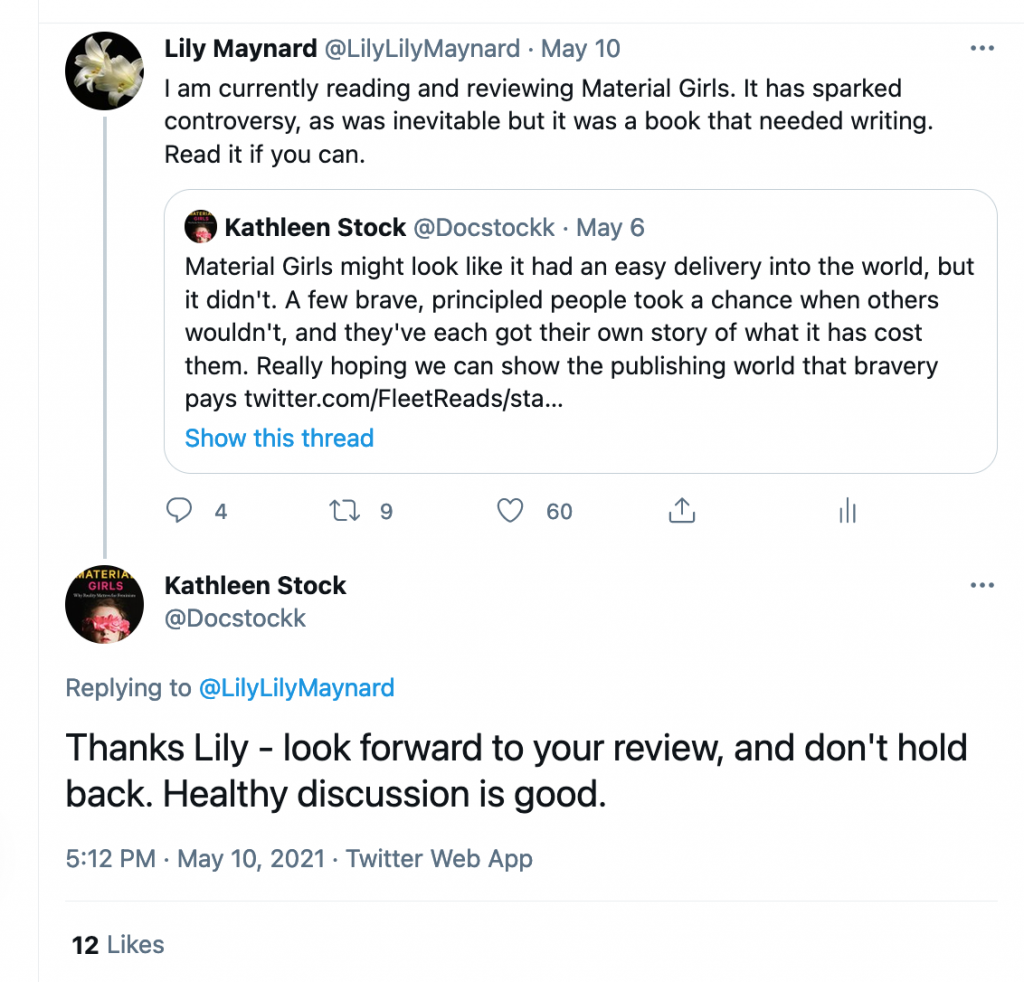
Apart from the use of the phrase ‘trans women’ and the use of the word ‘she’ to describe men, I got a lot from the book until the last chapter.
I am disconcerted by her willingness to speak disparaging of the work of feminists such as Jeffreys and Long, and by her calls for compromise. How do we compromise on an issue like this?
In writing Material Girls Stock has produced nearly 300 pages on an important subject and an additional 34 pages of notes, resulting in a detailed and thoughtful analysis. Where I disagreed with her, which I quite frequently did, I was encouraged to think over my own ideas and conclusions. It is good for us to have to do this, whatever the conclusions we reach.
I do understand that philosophy is speculative and that Stock wishes to view the issues from all angles. I took enough psychedelics in the 90s to realise that separating reality from illusion is fraught with problems and complexitites. As Poe said, ‘everything we see or seem is but a dream within a dream’.
I have thought long and hard about my opinion as to whether it is reasonable to refer to men as ‘she’ and to trans-identified men as ‘trans women’. I don’t believe it is. However, I am not a university professor, using my own voice, writing for the mainstream and wanting to hold on to my job.
If you can get hold of a copy of Material Girls, do. Whether you agree or disagree with the concepts therein, it’s a well structured piece offering food for thought.
As this is a review of Stock’s book, I should give her the last word.
On May 11th she wrote this on Twitter:
 “Some big mischaracterisations floating about, and a lot I could say, but I’m not going to be entering the radfem wars anytime soon. Me? I’ve got a book to sell to the mainstream about the multiple harms of gender identity ideology. I am absolutely clear what my mission is.”
“Some big mischaracterisations floating about, and a lot I could say, but I’m not going to be entering the radfem wars anytime soon. Me? I’ve got a book to sell to the mainstream about the multiple harms of gender identity ideology. I am absolutely clear what my mission is.”

Thank you so much for this! I, too, find Doc Stocm incomprehensible, especially considering she gets 75% of the way there and then just….panders to men?! UGH
Thank you.
Your review is worth reading (as are the criticisms from the TAs) and appreciated.
The only ‘surprises’ for me has been how blatant she has been in print re. Women she does not like and her poor scholarship re. history and research.
She has provided clear evidence of her character and her deficits.
She has a book to sell – indeed.
Excellent as usual!
Thank you Lily, this is a really interesting and comprehensive review.
Strange that a book purporting to be about material reality calls men women and downplays AGP. Pronouns are, indeed, rohypnol.
The nasty treatment of Sheila & Julia absolutely stinks. While use of preferred pronouns *may* have been necessary to get the book published, no publisher would’ve requested snarky dismissals of these brilliant women and their fantastic work.
She has a book to sell, but I’m not buying it — metaphorically or literally.
I’ll spend my nonfiction money on Jeffries, tyvm.
Since I started following the trans issue it has become painfully clear to me that Blanchard’s classification of trans-sexualism is spot on. The evidence is plainly available for the world to see in the behaviour of trans activists. It is as good as fact that the trans movement is driven by autogynephilic paraphiliacs whose goal is to permit legal practice of their fetish. The others are along for the ride – teen girls running from forced femininity, lesbians pretending they are men, and effeminate HSTS men pretending to be women (a bit more convincingly than AGPs).
Radical feminists have done some very heavy work fighting gender ideology, but like Stock they confine themselves to “theory” and intellectual sparring instead of tackling the issue with factual evidentiary approach. This issue is bigger than feminism – there are many more women than there are feminists. Time to drop the ideological pretence to “my theory (radical feminism) beats your theory (gender/queer)”.
As Nic says – pronouns are Rohypnol – there to condition society to accept this nonsense. Trans rights and womens’ are explicitly mutually exclusive and intellectuals like Stock are tying themselves in knots to avoid stating this conclusion since they don’t want to say NO to anyone. You can’t fake a middle ground here.
Pingback: 'Material Girls' breaks taboos, criticizing 'gender identity theory' from a philosophical perspective
Thank you for such a thoughtful précis.
I often buy books out of solidarity, rather than pleasure, and your reading will help mine.
Pingback: Good Intentions may have Unintended Consequences: My Response to the Letter Signed by Legal Academics in Support of Kathleen Stock – Catch These Words
Thanks for this thorough, thoughtful review.
I am quite dismayed by Stock’s cowardice when it comes to women saying no to men and her rather shocking dismissal and misrepresentation of feminism (“something called ‘the patriarchy”??? JFC – what planet does she live on??).
That said, I’ll be grateful for the parts she gets right and that this might help save a few more people from embracing the woman-hating that is transactivism.
Thank you so much for your review!
Can you (or anybody else) tell me what position she holds with regard to the “nature/nurture” debate?
I just saw that Richard Dawkins praised the book and he has a history of attacking feminist scientists for their opposition to “nature” narratives and believes in very traditional and patriarchal notions of “brain sex”. The fact that he likes Stock’s book so much makes me think that she may suppot similar positions in her book?
Can anyone confirm or deny that?
Thank you very much!
Thank you very much for your review! Not having read the book myself your review has confirmed the perception I have had of Stock and her book till today. I had the hunch that she would probably deconstruct some aspects of trans activism and the problems connected to it but at the same time also pander to men under the guise of “rationality”, “neutrality” and “measured moderation” which would stand in contrast to radical feminists who would be depicted as “too much”, “too shrill” and “too mean”. Whereas I am not surprised this whole narrative of “both sides” and that “radical feminists are also responsible” is incredibly frustrating.
I also fully agree with – and find it very refreshing to read – your arguments for using sex based pronouns, calling “transwomen” men (for completely factual reasons) and your criticism of Stock’s usage of preferred pronouns and terms such as “trans woman” (though I feel the same about “transwoman”) which – as you said – considering her endeavor to write about material reality feels not only counterproductive but also not thought through and not as logically consistent as one would desire to see from a philosopher.
Lastly, this sentence really sums up all of my feelings and seeing it written out was quite cathartic.
“If reality matters for feminism, does not honesty matter too?”
I am so tired of honesty and simple fact-stating being reframed as impolite and “not nice” even among feminists. It seems like the perfect way to manipulate us through our female socialisation and our strong wish to be nice and kind.
Stating facts about someone’s biological sex is not unkind. It does not mean you wish a person ill in any way nor that you think they don’t deserve human rights, dignity, safety and human decency. They deserve all that.
But they do not have the right to their own facts (here: on sex) and to dictate these personal “facts” to others, and their freedom ends where the freedom of another person begins.